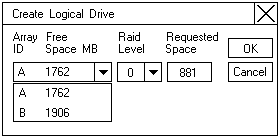Logical Drive Administration
Logical Drive Administration
Logical Drive Administration: This section contains
instructions for creating a logical drive, initializing and
synchronizing a logical drive, and accessing blocked
logical drives using the ServeRAID Administration and
Monitoring utility program.
Creating Logical Drives

You must create at least one logical drive for each disk array.
You can create up to eight logical drives.
If you plan to use the logical-drive migration (LDM) feature,
do not create more than seven logical drives. The LDM
procedure requires one free logical drive to perform the
migration. See 'Logical Drive Migration Administration'
for more information.
To create a logical drive:
- Click on the
 icon on the tool bar or select Manage Logical Drive from the Advanced
icon on the tool bar or select Manage Logical Drive from the Advanced
pull-down menu, then, select Create Logical Drive.
A screen similar to the following appears.

- Select the disk array ID for which you want to create a logical drive.
- Select the RAID level that you want to assign to the
logical drive from the pull-down list.
The RAID levels available depend on the number of
hard disk drives that you select for the disk array.
Note:
- If you have one hard disk drive, the logical drive can be only RAID level 0.
- If you have two or more hard disk drives, the logical drive can be RAID level 0 or 1.
- If you have three or more hard disk drives, the logical drive can be RAID level 0, 1, or 5.
- If you plan to use the Change RAID Level feature of logical drive migration, you must
assign the same RAID level to all of the logical drives in the array. See 'Changing RAID Levels'
for more information.
- Type the size, in megabytes, that you want to assign to the logical drive in the Requested Space entry field.
Note:
- The Requested Space default value is calculated as the maximum logical drive size available for
the RAID level assigned.
- The Requested Space must be between 2MB and the maximum available.
- The actual logical drive size that appears might be slightly different from what you type in the
Requested Space field.
The size of a logical drive is determined by the RAID level and the number of hard disk drives.
For example, a disk array consisting of three, 1GB hard disk drives with a requested RAID
level 0 drive of 1000MB will actually contain only 999MB because the data is striped across all
three drives, with 333MB on each drive.
- Click on OK to create the logical drive.
- You must initialize all new logical drives before storing data in them.
- Continue with 'Initializing Logical Drives'
Note:
All new RAID level 5 logical drives are automatically synchronized when you initialize them.
Back to 
Please see the LEGAL - Trademark notice.
Feel free - send a  for any BUG on this page found - Thank you.
for any BUG on this page found - Thank you.


